

Teachers.Net March 2011 - HARRY & ROSEMARY WONG: Effective Teaching - Achieving Greatness - Teachers.Net. Learning Objectives: The Heart of Every Lesson A Philadelphia Consulting Teacher We met Michelle Shields while working with the new teachers in the School District of Philadelphia in August 2010.
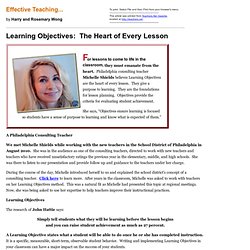
She was in the audience as one of the consulting teachers, directed to work with new teachers and teachers who have received unsatisfactory ratings the previous year in the elementary, middle, and high schools. She was there to listen to our presentation and provide follow up and guidance to the teachers under her charge. During the course of the day, Michelle introduced herself to us and explained the school district’s concept of a consulting teacher. Learning Objectives The research of John Hattie says: Simply tell students what they will be learning before the lesson begins and you can raise student achievement as much as 27 percent. A Learning Objective states what a student will be able to do once he or she has completed instruction. A Learning Objective is a statement that tells the student:
MyRead – Explicit Teaching. Christine Edwards-Groves Building a culture of learning within today’s classrooms requires teachers and students to jointly engage in teaching and learning that is purposeful, relevant and clearly defined.
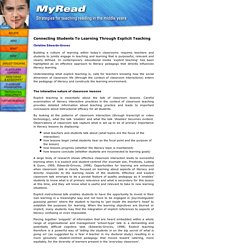
In contemporary educational media ‘explicit teaching’ has been highlighted as an effective approach to literacy pedagogy that directly influences literacy learning. Understanding what explicit teaching is, calls for teachers knowing how the social dimension of classroom life (through the context of classroom interactions) enters the pedagogy of literacy and constructs the learning environment. The interactive nature of classroom lessons Explicit teaching is essentially about the talk of classroom lessons. By looking at the patterns of classroom interaction (through transcript or video technology), what the talk ‘enables’ and what the talk ‘disables’ becomes evident.
Explicit Teaching – Student-Centred Learning Across The Developmental Continuum. Resources for Teachers. We know that students learn best when they are truly engaged in what they are learning, when they have the opportunity to explore, debate, discuss, examine, defend, and experiment with the concepts and skills they are ready to learn.
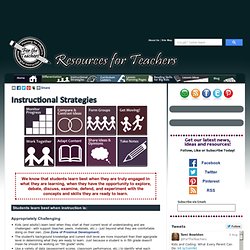
Students learn best when instruction is: Appropriately Challenging Kids (and adults!) Learn best when they start at their current level of understanding and are challenged - with support (teacher, peers, materials, etc.) - just beyond what they are comfortable doing on their own. (See Zone of Proximal Development) The student's background knowledge and current skill level are more important than their age/grade level in determining what they are ready to learn. Classroom Grouping Strategies for High School Teachers and Business Meetings. Gone are the days of students sitting on straight rows for an entire class of lecture.
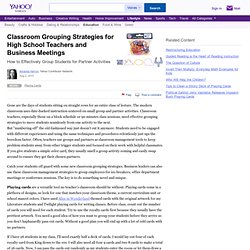
The modern classroom uses date-backed instruction centered on small group and partner activities. Classroom teachers, especially those on a block schedule or 90 minutes class sessions, need effective grouping strategies to move students seamlessly from one activity to the next. But "numbering off" the old-fashioned way just doesn't cut it anymore. Students need to be engaged with different experiences and using the same techniques and procedures relentlessly just ups the boredom factor. Research for Better Teaching - RBT Free Downloads. Rasmussen. Student Participation/Active Learning- Teaching Tips. Student Participation/Active Learning Tips marked with an * indicates that the tip is consistent with learnng-centered teaching Student Participation/Active Learning *Getting students to participate in class Here are a few simple strategies to get students to respond to questions or participate more: give students a clue regarding the kind of response that your are expecting give students a minute to write their thoughts before anyone is called upon break students into small groups to discuss the answer, then bring them back to the whole group arrive early to class and chat with students informally (helps them fail more comfortable) use non-verbal means to invite people to participate - sit close to students, make eye contact with them individually, move around the room, or sit in different locations. back to top *Promoting class participation, discussion among the entire class.
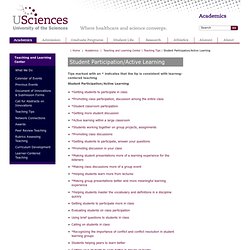
Student Participation/Active Learning- Teaching Tips. 10 Creative Ways to Form Groups - Flip It Consulting. When you think about flipping your classroom or training session, think about using group work.

Group work is an excellent way to build community, enhance collaboration, increase engagement and improve critical thinking skills. Incorporating opportunities for your learners to connect with their colleagues on a regular basis establishes a welcoming learning environment and builds their capacity to be successful in groups when they are faced with a long-term project. Often, instructors and trainers generate discussion by asking their students or participants to turn to their neighbor or get into groups based on how the seats are arranged.
While this is convenient, there are more creative ways to divide people into groups. Here are ten ways you can mix up your classroom or training sessions and increase opportunities for your participants to engage with all of their peers, not just those who sit close by. Idea # 1 Put 4 or 5 different kinds of candy in a bag. Idea #2 Idea #4 Idea #5 Idea #6.